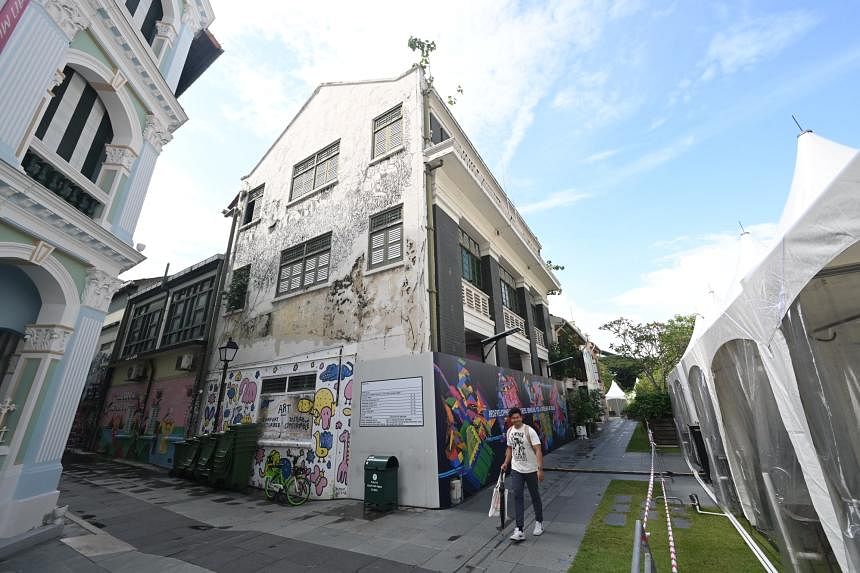SINGAPORE – The redevelopment of the 14,000 sq ft arts space at 45 Armenian Street, formerly The Substation, will be completed in 2026, while five double-storey units at 52 to 56 Kampong Java meant to add affordable studio space for artists are on track to open at the end of 2024.
Minister of State for Culture, Community and Youth Low Yen Ling made the announcement during the parliamentary debate on her ministry’s budget on March 7, as she sought to assure the arts community that there will be sufficient spaces for its growth.
With Gillman Barracks being studied as a potential site for housing, Ms Low said the more than 10 art galleries in the arts cluster will be allowed to stay till the end of their leases, which progressively expire by 2030.
Whether they will be allowed to stay on subsequently will be assessed again after the authorities’ heritage and environment studies of the area are completed. These are slated to begin in the second quarter of 2024.
Ms Low said in response to questions from arts Nominated MP Usha Chandradas: “If some of them are planning or thinking of relocation, we will certainly work together with the relevant agencies to facilitate their relocation, for example, by pointing them to available spaces that they can consider.”
She added: “We are committed to supporting the development of a vibrant and sustainable art sector in Singapore.” She said gross floor area for the arts has risen from 66,000 sq m in 2010 to 94,000 sq m in 2023 – a 42 per cent increase.
According to the Ministry of Culture, Community and Youth’s (MCCY) expenditure plans, the redevelopment of 45 Armenian Street is expected to cost $12.7 million, including $825,000 in financial year 2024.

Plans also show that the development of National Arts Council’s (NAC) Catch.sg online platform, a one-stop shop for arts and culture currently in beta mode, will come up to $5.7 million.
The 2021 closure of The Substation, which had cemented itself as a fixture in Singapore’s indie arts scene, was a disputed one.
The Substation board decided to leave the building after NAC said it could return to the building only as a co-tenant – a downgrade from its previous sole operator status – citing “the loss of autonomy over the spaces and facilities crucial for its mission, and the loss of income from venue hiring”.
More than 100 members of the arts community also raised concerns that the space’s fierce reputation for independence could be compromised with custodianship returned to the NAC.
In Parliament, Ms Chandradas asked if the ministry could shed more light on its plans for 45 Armenian Street, and asked if there were lessons to be learnt from The Substation saga.
She quoted Minister for Culture, Community and Youth Edwin Tong’s comments on Kampong Java spaces that the arts community should be allowed to take the lead and that “a little bit of messiness” might be desirable.
Ms Low said NAC has been working with stakeholders to co-create the space “as a hub for artistic experimentation and to support the work of young and emerging practitioners”. She did not provide more details.
Separately, Ms Chandradas also asked if the ministry would consider converting the Cultural Medallion award – the highest cultural accolade in the country – to a cash grant, such as those awarded to medalling athletes.
Currently, Cultural Medallion recipients are allowed to apply for a fund of up to $80,000 to support their projects throughout their lifetime. These must involve certain objectives such as the mentoring of younger artists and the development of the artist’s own practice.
The administrative process and strings attached could have led to the funds not being fully utilised, said Ms Chandradas. Of the $9.4 million awarded to recipients since 2001, $3.4 million, or 36 per cent, remains unused as at January 2024, according to MCCY. Forty-one per cent of recipients who have died also did not access any of their eligible funding.
Ms Chandradas said cash awards “recognise the huge costs of training at an elite level” for athletes.
“Artists, too, when they are at a developmental stage of their careers, incur significant costs in maintaining and growing their artistic practices. A cash award would allow for better practical access to and actual use of their award funds,” she added.
Ms Low said the NAC has over the years broadened the range of projects that the Cultural Medallion fund can support.
She did not address the suggestion directly, but said the process for recipients to use the fund has been continually simplified.


